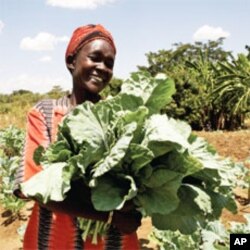Women farmers hold the “key” to sharply reducing world hunger, according to a new report from the humanitarian organization ActionAid.
The release of the report – Fertile Ground -- coincides with a European Union meeting Wednesday in Brussels to revive efforts to achieve the Millennium Developments Goals (MDGs).
It’s estimated there are about one-billion people who go hungry every day. A Millennium Development Goal is to reduce that number by half by 2015.
Food producers
Peter O’Driscoll, executive director of ActionAid USA, says there are a number of reasons to invest in women farmers.
“First and foremost, particularly in places like Africa where the hunger problem is most severe, women produce most of the food. In some countries 70, 80 even 90 percent of the food people consume is produced by women small farmers,” he says.
However, he says these women lack the necessary tools and resources.
“Investment in agriculture, investment in land, credit and so forth are simply not available for women farmers. So, what we’re trying to insist is that it’s crucial not only that governments increase the level of spending and investment in agriculture, but that they target it towards women,” says O’Driscoll, adding, “If you really want to address the problem of hunger, you have to invest in hungry people in helping them to grow their own food,” says O’Driscoll.
Farmers go hungry, too
The ActionAid USA head estimates there are 800-million smallholder farmers around the world, who produce most of the food consumed in their countries.
“But it’s also important to note that when we talk about a billion hungry people in the world, probably 60 percent of those are smallholder farmers and another 20 percent are landless rural workers. So, clearly, the folks who are growing the food are also those who are experiencing the most chronic hunger,” he says.
In Africa, women make up the majority of these smallholder farmers. But O’Driscoll says men and women often produce food for different reasons.
“Men, who have better access to credit and better access to extension services, tend to produce cash crops for market, whereas women actually grow the food that their families will be eating.”
Investing
O’Driscoll says it’s now generally accepted that it was a mistake to reduce investment in agriculture over the past 25 years or so.
“There was an idea that if we simply got the government out of agriculture, and allow the private sector to come in, we’d have a more efficient and effective food system. Unfortunately, the results are that number of hungry people has actually dramatically increased over that time,” he says.
Besides investing more money, the ActionAid official says it should also be more targeted.
“We should be targeting that aid on the kinds of inputs that are most useful to those women,” he says.
This includes access to credit and agricultural extension services, which aim to improve the economic, environmental and social conditions of the farmers.
“Even where extension services are available, they tend to focus on the richer farmers, who have access to markets. They’re not reaching the kind of women who are actually growing the food that people need to escape from hunger,” he says.
Tiny farms
Many women farmers grow food on small patches of land. But O’Driscoll says that land can be made more productive.
“For many years the conventional wisdom has been that these pieces of land are too small and too unproductive and, therefore, not worth farming at all,” he says.
That attitude contributed to a “dramatic exodus from rural areas to cities.” But things are changing.
“There’s a tremendous body of evidence that investment in sustainable agricultural techniques - in multi-cropping, diversified cropping, in agro-ecological composting and various other forms of low cost, low external input agriculture – can actually be extremely productive,” he says.
2015
Would investing in smallholder women farmers help achieve the Millennium Development Goal to halve hunger around the world by 2015.?
O’Driscoll says, “I think as a global community we simply have to take that as an imperative. I think it’s probably now almost…35 years that the international community has been promising to halve the number of hungry people,” he says.
He says the question is not whether it can be done, but how the world commits to doing it.
“As this report makes pretty clear, there is a number of dimensions. One is we do need to see a dramatic increase…in public investment in agriculture. And that means not only from African countries or developing countries themselves…but I think it’s clearly important for the donor community…to step up their giving,” he says.
The EU meeting in Brussels aims to come up with a “rescue” plan for the MDGs.










